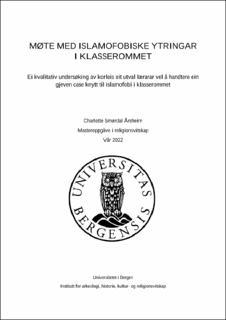| dc.contributor.author | Årsheim, Charlotte Smørdal | |
| dc.date.accessioned | 2022-06-18T00:09:45Z | |
| dc.date.available | 2022-06-18T00:09:45Z | |
| dc.date.issued | 2022-05-20 | |
| dc.date.submitted | 2022-06-17T22:00:38Z | |
| dc.identifier.uri | https://hdl.handle.net/11250/2999382 | |
| dc.description.abstract | Føremålet med denne studien er å få eit innblikk i korleis lærerar handterer situasjonar kopla til hatefulle ytringar i klasserommet, med eit spesielt søkelys på islamofobiske ytringar. Bakgrunnen for studien er den aukande trenden med hat mot muslimar i dagens samfunn. Eg har anvendt eit kvalitativt forskningsdesign, der eg har gjennomført tre fokusgruppeintervju med ni lærarar frå ulike vidaregåande skular i Noreg. Studien illustrerer korleis lærarar vel å handtere situasjonar der islamofobi har nådd klasserommet. For å belyse mine funn har eg nytta meg av teoretiske perspektiv knytt til handtering av hatefulle og fordomsfylte ytringer, islamofobi, safe space, brave space, relasjonsteori og normkritisk pedagogikk. Analysen viser at lærarar med mykje erfaring har betre utgangspunkt for å handtere situasjonar knytt til islamofobiske ytringer i klasserommet. Ved å prøve og feile får lærarane teste ut kva strategiar som funkar til føremålet. Nokre lærarar verkar tryggare i måten dei ynskte å handtere casen på, som igjen kan knytast til nettopp tidlegare erfaringar. Denne studien ser òg på nokre ulike tilbod skular har tilgjengelig, og korleis tilboda hjelp lærarane med å handtere desse situasjonane. | |
| dc.description.abstract | The purpose of this study has been to gain insight into how teachers handle situations linked to hate speech in the classroom with a special focus on Islamophobic speech. This work is increasingly relevant given the growing trend of hatred directed towards Muslims today, and the importance of having enough knowledge to deal with situations where pupils express such opinions in the classroom. I used a qualitative research design and conducted three focus group interviews with nine teachers from different upper secondary schools in Norway. The study illustrates how teachers choose to deal with instances of Islamophobia in their classrooms. To shed light on my findings, I used theoretical perspectives related to responding to hateful and prejudiced statements, Islamophobia, safe space, brave space, teacher-student relationship, and norm-critical pedagogy. The analysis shows that teachers with greater experience have a better starting point to address Islamophobic statements made in the classroom. By trying and failing, teachers learn which strategies work in various situations. Some teachers seem more confident in their ability to handle the case, which in turn can be linked to previous experiences. This study also examines some of the different programme’s schools have available, and how these programmes help teachers deal with these situations. | |
| dc.language.iso | nno | |
| dc.publisher | The University of Bergen | |
| dc.rights | Copyright the Author. All rights reserved | |
| dc.subject | relasjonsteori | |
| dc.subject | safe space | |
| dc.subject | Islamofobi i klasserommet | |
| dc.subject | normkritisk pedagogikk | |
| dc.subject | brave space | |
| dc.title | Møte med islamofobiske ytringar i klasserommet | |
| dc.title.alternative | Addressing Islamophobic Statements in the Classroom | |
| dc.type | Master thesis | |
| dc.date.updated | 2022-06-17T22:00:38Z | |
| dc.rights.holder | Copyright the Author. All rights reserved | |
| dc.description.degree | Religionsvitenskap mastergradsoppgave | |
| dc.description.localcode | RELV350 | |
| dc.description.localcode | MAHF-LÆHR | |
| dc.description.localcode | MAHF-RELV | |
| dc.subject.nus | 714218 | |
| fs.subjectcode | RELV350 | |
| fs.unitcode | 11-22-0 | |
